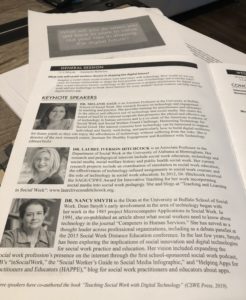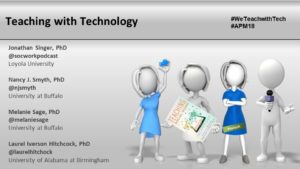#SWDE 2019 – Imagining Social Work Education into the Future: Skills for Social Justice in a Technology-Mediated World
On April 11th, Melanie Sage, Ellen Belluomini, and I presented at the 2019 Social Work Distance Education Conference in San Antonio, TX on a topic that is beginning to get some traction in social work – the future of social work education for practice with technology. Technology is profoundly shaping the world, especially in the delivery of education. Concurrently, services like telehealth, predictive analytics, and technology aids (i.e. Fitbits, apps and home listening devices) affect service delivery. Given these changes, how do social workers promote social justice and support privacy and equity? And consider needs of the vulnerable while harnessing technology for good? How does social work redefine the profession in the face of algorithmic solutions to human problems? Our goal was to introduce a dialogue about what’s happening, where are gaps in social work education, and how programs might reinvent in a rapidly-changing environment.
If you were not all to make the session or didn’t attend the conference, we are sharing information from the presentation, to make the content more accessible to all and to help promote more discourse among social workers about the future of the profession.
Here are the slides from the presentation:
#SWDE2019 Keynote – What role will Social Workers choose in shaping the digital future?

On April 10th, Melanie Sage, Nancy Smyth, and I delivered a keynote speech at the 2019 Social Work Distance Education Conference in San Antonio, TX. We asked social work educators to imagine a world where social workers were innovators with technology. Our goal was to have a conversation and share how we had been talking about technology will writing our book – Teaching Social Work with Digital Technology.
We started our conversation about how social workers could help close the digital justice gap on Twitter, moving from virtual spaces to physical spaces. Many social workers joined in this conversation along the way. We talked about a range of issues from boundary and privacy challenges to accessibility and connection with technology. As Nancy said, “we were near-sighted as a profession. We need to look through the lens of possibilities, not the lens of our fears.”
In this blog post, we are sharing highlights, references, and slides from the keynote. We hope you will help us continue the conversation together and in your places of work and community.
#SWDE2019 – Incorporating Technology into Social Justice Assignments for Social Work Education
Today is Day One of the fifth annual Social Work Distance Education Conference at the St. Anthony Hotel in San Antonio, TX. The wonderful faculty and staff at Our Lady of the Lake University Worden School of Social Service are once again hosting this wonderful conference. This year’s theme focuses on how pedagogy in social work education can advance social justice. With our new book out, Teaching Social Work with Digital Technology, Melanie Sage, Nancy Smyth, and I decided to share some insights from Chapter 4 about how Puentedura’s SAMR Model for Technology Integration can be used to incorporate technology into traditional social justice assignments in social work education. We are presenting at 3:00 PM CST in the Jones Room.
For those of you who can’t make the presentation, we are including the details in this blog post.
Review of Teaching & Learning in Social Work for 2018
One of the reasons I like a good “end-of-the-year list” is the opportunity to reflect on what I did and did not miss out on over the past year. I’m always thrilled to discover I read one or maybe even two of the most notable books on the New York Times yearly list. Then, I start planning my reading wish list for the coming year, which usually involves magical thinking about reading every winner of the Nobel Prize for Literature or the all the Pulitzer Prize winners for Non-Fiction from the last ten years. Even if I don’t actually read all of these books, I believe in having some goals for my reading and other activities. For the Teaching and Learning in Social Work Blog, I had three goals for 2018:
1 .Write or publish 30 blog posts
2. Increase the number of blog subscribers from 100 to 200
3. Publish 10 guest educator blog posts
Here is how those goals worked out:
1. Wrote only 13 blog posts during the year, but published a total of 21 posts (70% completed)
2. Only added 40 more subscribers to the blog (40% completed)
3. Published 8 guest educators posts (80% completed)
While not all my goals were achieved, I was still able to collaborate with others to accomplish some solid writing for the blog including information about projects that I have been working on, and all my conference presentations for the year. Below is a list of this year’s posts, grouped around the topics of projects, guest educator posts, and conference presentations.
Projects: These posts describe new projects that I started or worked on during 2018:
Using an Interprofessional Perspective for NASW’s Technology Standard for Social Work Education
 On Saturday, November 10, 2018 at 7:30 am in Dolphin, Walt Disney World Resort, Asia 3, Lobby/Third Level, I will be presenting with Drs. Melanie Sage and Nancy J. Smyth about our crowd sourced work, Social Work Educators’ Perspectives on NASW’s Technology Standard for Education, Training, and Supervision. We will be distributing printed copies of our booklet and sharing how social work educators can bring an interprofessional perspective to teaching with technology.
On Saturday, November 10, 2018 at 7:30 am in Dolphin, Walt Disney World Resort, Asia 3, Lobby/Third Level, I will be presenting with Drs. Melanie Sage and Nancy J. Smyth about our crowd sourced work, Social Work Educators’ Perspectives on NASW’s Technology Standard for Education, Training, and Supervision. We will be distributing printed copies of our booklet and sharing how social work educators can bring an interprofessional perspective to teaching with technology.
In 2017, new Standards for Technology in Social Work Practice were issued by NASW (and written in conjunction with CSWA, CSWE, and ASWB) to address the intersections of social work practice and technology. One of the standards (standard 4) focuses on technology for social work education, training, and supervision, while the other standards focus on the use of technology in social work practice.
After the standards came out, social work educators told us they wanted more information about how to actually use the guidance from the standards in their classrooms and universities. We (Laurel Hitchcock, Melanie Sage, and Nancy Smyth) reached out to social work educators and supervisors who have specialized knowledge of teaching and supervision with technology to provide more information related to interpretations. We used Google Docs to create a place for contributors to share their comments for how the educational standards should look in practice, the best practices related to standards, and the ways educators and supervisors can aspire to best practices related to technology. Then, we edited the ideas and comments by all the contributors into a cohesive document to provide guidance for educators.
To help disseminate this work, the University at Buffalo’s School of Social Work agreed to publish it as a booklet, and we distributed this for the first time in at the 2018 Social Work Distance Education Conference in San Antonio, TX.
Here you will find a link to the digital copy of crowd-sourced technology standards: https://tinyurl.com/SWEdTechStandards
You can access a copy of presentation slides here: https://drive.google.com/file/d/17MUD49n79hkwzlqcq20cvtt5IZJc9Rge/view?usp=sharing
Here is our conference proposal with learning objectives:
By the end of the session, participants will:
#APM18 Teaching with Technology using the SAMR Model
 On Thursday, November 8, 2018, I will be presenting with Jonathan Singer, Melanie Sage & Nancy J. Smyth the Teaching Institute for Early Career Faculty at the Council on Social Work Education’s 2018 Annual Program Meeting. In this session, we are focusing on how faculty can incorporate technology into a social work course. All educators, especially those early in their careers, find themselves teaching from syllabi they had no role in developing. Although there are many benefits to the “hand-me-down” syllabus, one of the limitations is that assignments are rarely updated to reflect the realities of the 21st century workplace, which now includes the use of technology to achieve practice outcomes for clients and organizations. The purpose of this workshop is to learn about how to incorporate the use technology into a social work assignment on your syllabus, using Puentedura’s SAMR Module for Technology Integration. We will provide a brief overview of teaching with technology before focusing on how to infuse technology into an assignment from your syllabus, including learning objectives and associated assessment techniques in your syllabus. Participants will learn to identify ways to substitute, augment, modify or redefine existing learning strategies and assignments with technology-mediated learning strategies and assignments. By the end of the session, the participant will have an assignment that uses technology to meet the learning needs identified in the syllabus.
On Thursday, November 8, 2018, I will be presenting with Jonathan Singer, Melanie Sage & Nancy J. Smyth the Teaching Institute for Early Career Faculty at the Council on Social Work Education’s 2018 Annual Program Meeting. In this session, we are focusing on how faculty can incorporate technology into a social work course. All educators, especially those early in their careers, find themselves teaching from syllabi they had no role in developing. Although there are many benefits to the “hand-me-down” syllabus, one of the limitations is that assignments are rarely updated to reflect the realities of the 21st century workplace, which now includes the use of technology to achieve practice outcomes for clients and organizations. The purpose of this workshop is to learn about how to incorporate the use technology into a social work assignment on your syllabus, using Puentedura’s SAMR Module for Technology Integration. We will provide a brief overview of teaching with technology before focusing on how to infuse technology into an assignment from your syllabus, including learning objectives and associated assessment techniques in your syllabus. Participants will learn to identify ways to substitute, augment, modify or redefine existing learning strategies and assignments with technology-mediated learning strategies and assignments. By the end of the session, the participant will have an assignment that uses technology to meet the learning needs identified in the syllabus.



